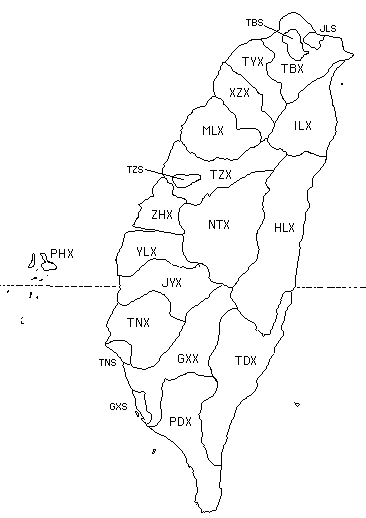
Content created: 2012-02-19
File last modified:


Two Tables:The first table contains a list of Táiwān 臺灣 / 台湾 place names arranged by administrative district (within which they are alphabetical). The second table contains the same information in a continuous alphabetical list. In both lists, each place name is accompanied by a three-letter abbreviation indicating the administrative district where the place is located (although that is redundant in Table 1).
Spellings:Taiwan is notoriously inaccurate and inconsistent in Romanized spellings of Chinese names. The only spellings used here follow internationally standard Hanyu Pinyin system, so if you go from a printed source, you may need to do some creative reinterpretation to locate the name in this list. Parts of cities called “north district,” “south district,” or the like have been omitted in the tables.
Map: The simple map at the top of this page and of the two pages of tables is a link to a separate page with official spellings of major place names (link). On that page a printer-friendly copy is available by clicking on the map.
Source: The information in the tables are derived from the 1985 printing of Taiwan's zip code directory (Yóudì Qūhào Yīlǎnbiǎo 郵遞區號一覽表 / 邮递区号一览表). They include about 400 names of municipalities (shì 市) and counties (xiàn 縣 / 县) and of their immediately subordinate districts, xiāng 鄉 / 乡, zhèn 鎮 / 镇, and qū 區 / 区. The first three digits of the 5-digit zip codes are also included here, since they occasionally help in locating a name on the map.
Changes: Taiwan places have undergone many changes of name and status both before and after 1985, but the 1985 name set is probably the most useful one for most students of Taiwan history. The terms xiàn, xiāng, and zhèn are left untranslated. The term shì is sometimes left untranslated, sometimes translated as “city.” Without these suffixes, the same name may be applied both to a rural xiāng and to an urban qū, say. But as long as these suffixes are included there are no duplicate place names in Taiwan.
Province & Province-Level Municipalities (Cities): For most of the last half century or so, Táiběi 臺北 / 台北 and Gāoxióng 高雄 have had the status of “special municipalities,” which meant that administratively they were at the same level as a province and technically were no longer part of Taiwan Province. (However their hinterlands remained within the province as xiàn.)
Xiàn & Xiàn-Level Municipalities (Cities): The remainder of Taiwan was divided into cantons or counties called Xiàn 縣 / 县. The hinterlands around the special municipalities were also xiàn. For example, there is not only a Gāoxióng City, but also a Gāoxióng Xiàn. In addition, on the analogy of the province-level “special municipalities,” three smaller cities —Jīlóng 基隆, Táizhōng 臺中 / 台中, and Táinán 臺南 / 台南 — received the status of xiàn-level special municipalities. Of the three, only Jīlóng did not have a hinterland with the same name lying outside of municipal jurisdiction.
Urban Districts & Neighborhoods: Cities are divided into districts or qū 區 / 区, which in turn are divided into neighborhoods neighborhoods (lǐ 里) and/or streets.
Rural Zhèn and Xiāng: The counties or xiàn were in turn subdivided into two kinds of rural units called zhèn 鎮 / 镇 and xiāng 鄉 / 乡.
The difference between the two kinds of rural districts, the zhèn and the xiāng, is of little importance to most people, but technically zhèn are entirely comprised of neighborhoods called lǐ 里 (sometimes subdivided into lín 鄰 / 邻), while xiāng are directly administered by a xiāng government, but contain bounded cūn 村 or villages with "unincorporated" space between them. Most people think of zhèn as more heavily populated, “more urban,” than xiāng, but that is not always the case.
A map of Taiwan before 1945 would have had Japanese names. A map before 1895 would have had Chinese names, but often not the same names used today. And naturally as population increased over the centuries, administrative units and place names multiplied. The process continues.
Táinán: In 2010, Táinán City, formerly a xiàn-level special municipality, absorbed Táinán Xiàn and was elevated to join Táiběi and Gāoxióng as a province-level special municipality. In geographical area, it instantly became the largest of the three, and Táinán Xiàn has now officially ceased to exist.
The change of status of Táinán Xiàn in 2010 means that its many former xiāng and zhèn are now urban qū. These changes are NOT reflected in the present table and they are recent enough that it is unlikely they will be reflected in most of your reading materials.
New Táiběi: Shortly afterward, also in 2010, Táiběi Xiàn was redefined as a special municipality (displacing Táinán as the largest) and renamed Xīnběi Shì 新北市 "New North City" in Chinese. The official English name is "New Taipei City" (to avoid a spelling with the "Communist" letters X and B in the originally proposed English transcription as "Xinbei City"). As with Táinán Xiàn's conversion into a special municipality, this resulted in former xiāng and zhèn in Táiběi Xiàn being redefined as urban qū. Once again, these changes are NOT reflected in the present table and they are recent enough that it is unlikely they will be reflected in most of your reading materials.